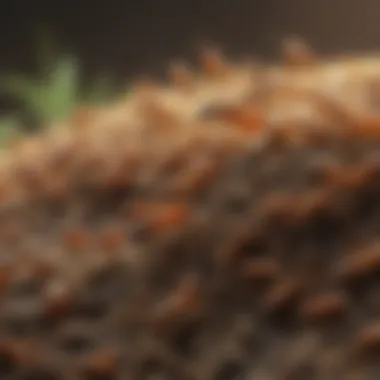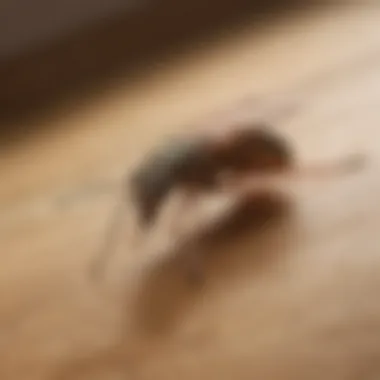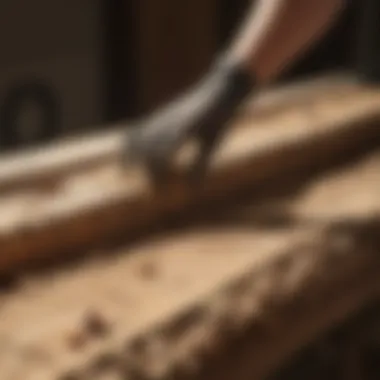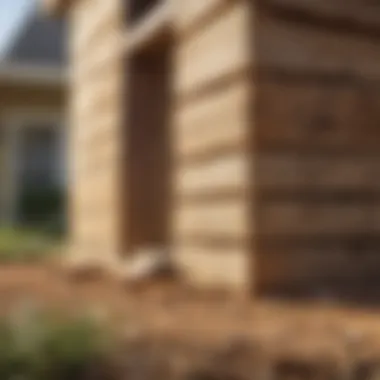Understanding Emco Termite: Effective Pest Control Solutions


Intro
Understanding pest control is vital for homeowners. Among the various pests, termites deserve particular attention. Emco Termite stands out as a significant player in addressing this issue. This section will provide insights into the nature of pests, especially termites, and highlight preventative measures and eco-friendly solutions.
Termites can cause severe damage to homes if left unchecked. Recognizing their behaviors and biology is essential for becoming proactive in pest management. This article aims to equip readers with practical knowledge about termite species, their habits, and what homeowners can do to protect their properties.
Understanding Pests
Definition of Pests
Pests are organisms that can harm or disrupt human activities. They can include insects, rodents, and other wildlife. In the context of homes, pests like termites can damage the structural integrity of buildings. Therefore, understanding them is crucial.
Importance of Pest Identification
Identifying pests correctly is the first step in effective pest management. For homeowners, misidentification can lead to ineffective treatments or overlooking a severe infestation. Understanding termite species and their specific behaviors allows for targeted control measures.
"Timely identification of pests helps in curtailing the damages they can cause."
Prevention Techniques
Home and Garden Preventative Measures
- Keep wood stored away from the foundation of your home.
- Maintain a dry environment; termites are attracted to moisture.
- Use sealants on cracks and gaps in foundations and walls.
- Regular inspections of your home and garden help identify potential risks early on.
Seasonal Prevention Tips
Seasonal changes can influence pest behavior. For termites, spring is generally a time of increased activity.
- Spring: Inspect your home for signs of swarming or mud tubes.
- Summer: Ensure your yard is clear of debris that can harbor termites.
- Fall: Seal any entry points to your home before winter.
- Winter: Regular monitoring can help catch potential infestations before they grow.
Eco-Friendly Pest Control Solutions
Overview of Sustainable Practices
With growing concerns about the environment, eco-friendly pest control has become essential. Sustainable practices not only address pest issues but also protect the ecosystem.
Natural Remedies and Their Effectiveness
Homeowners might prefer natural remedies, either alone or combined with chemical treatments. Examples include:
- Boric acid: Effective against termites, it acts by disrupting their digestive systems.
- Neem oil: A natural insect repellent that can deter a variety of pests.
- Diatomaceous earth: When applied, it can desiccate any insect that comes into contact.
Many natural methods require persistence but can be beneficial in protecting homes without harmful chemicals.
Prelims to Emco Termite
Understanding Emco Termite provides a fundamental basis for addressing termite issues that homeowners face. This section plays a crucial role in introducing readers to the company and the services it offers in the realm of pest control. By delving into Emco's identity and its historical background, we will gain insights into its commitment to effective pest solutions and customer education.
What is Emco Termite?
Emco Termite is a pest control company that specializes in the management and eradication of termite infestations. They use a combination of advanced technology and traditional methods to protect homes from these destructive pests. Their services are designed to offer comprehensive assessments, treatments, and preventative solutions, ensuring that properties are safeguarded against future infestations. This dedication to thorough pest management is essential for homeowners who want to maintain the integrity of their properties.
History of Emco in Pest Control
The history of Emco Termite is rich with efforts aimed at providing effective pest control solutions. Founded several decades ago, Emco quickly established itself as a trusted name in pest management. With a focus on innovation and customer service, the company has adapted its methods and products over time to meet evolving pest challenges. This adaptability has allowed Emco to remain at the forefront of the pest control industry, reaffirming its dedication to protecting homes and properties against the threat of termites.
Emco’s commitment to education also sets it apart. They prioritize informing homeowners about the nature of termite behavior, prevention strategies, and the importance of early detection.
The Biology of Termites


Understanding the biology of termites is essential for effective pest management. Termites play crucial roles in their ecosystems, but they can cause substantial damage to homes. By gaining insights into their biology, homeowners can make informed choices regarding prevention and treatment. This section explains the types of termites, their lifecycle, and their colony structure. Knowing these aspects aids in recognizing the threats they pose and the appropriate strategies for control.
Types of Termites
Subterranean Termites
Subterranean termites are often considered the most destructive type of termite. They build their colonies underground, making it hard to spot them until significant damage occurs. Their key characteristic is their ability to chew through wood while remaining concealed. This behavior allows them to remain undetected and can lead to extensive property damage.
One unique feature of subterranean termites is their need for moisture. They create mud tubes to connect their nests to their food sources while maintaining humidity. This aspect means that proper management must address moisture control around foundations. Their destructive potential makes understanding their habits key to implementing effective control measures.
Drywood Termites
Drywood termites differ significantly from subterranean types. They do not require contact with soil moisture and can infest wood above ground. A notable characteristic is their habit of living within the wood they consume, allowing for internal damage without noticeable external signs.
Drywood termites can go unnoticed for a long time, leading to devastating consequences. Their unique feature lies in their ability to produce frass, a sign of their presence. Identifying this frass in woodwork is vital for early intervention. Their behavior requires distinct approach within pest control, as eradication often involves treating the wood directly.
Formosan Termites
Formosan termites are known for their aggressive nature and large colonies. They are especially problematic in warmer climates and can cause more rapid destruction than other types. A key characteristic of Formosan termites is their ability to adapt and thrive in various environments, making them particularly resilient.
A unique feature of Formosan termites is their voracious appetite. They can consume wood, paper, and even plastic materials. This broad diet means they can infiltrate multiple parts of a home, intensifying the risk of infestation. Understanding their breeding habits and adaptability is crucial for developing effective pest control strategies.
Termite Lifecycle
Egg Stage
The egg stage is fundamental to the termite lifecycle. After mating, the queen lays eggs, which become the foundation of a new colony. A key characteristic of this stage is its rapid progression; eggs can hatch in a matter of weeks.
This stage is beneficial for the overall lifecycle, as it sets the stage for future colony expansion. However, these eggs are vulnerable to environmental factors, making understanding their conditions crucial for pest management.
Nymph Stage
Following the egg stage, termites enter the nymph stage. Here, they resemble smaller versions of adult termites and undergo several molts before becoming adults. A key characteristic of this stage is its role in deciding the future roles within the colony.
Understanding the nymph stage is essential, as disruptions in their development can impact colony dynamics. Effective control strategies often target this stage to prevent them from maturing into destructive adults.
Adult Termites
Adult termites are the reproductive and functional members of the colony. Their key characteristic is the division of labor, as they specialize into queens, workers, or soldiers. This structure ensures the success and survival of the colony as a whole.
One unique feature is the queen's ability to lay thousands of eggs daily, propelling colony growth. Adults also have distinct roles that impact ecosystem health, making understanding their function critical when developing pest control methods.
Colony Structure and Roles
Queen
The queen is central to the termite colony’s survival. She remains deep within the colony, propagating new termites. Her key characteristic includes the incredible capacity to reproduce, setting the colony's growth.
Her unique feature is the ability to store sperm and regulate egg-laying based on environmental conditions. Understanding her role helps in creating effective strategies to disrupt reproduction within infested homes.
Workers
Workers are the backbone of the termite colony. They handle all duties, from foraging to nest maintenance. Their key characteristic includes their strong ability to locate and consume cellulose sources.
These workers also communicate damage to the colony, a critical aspect when assessing structural integrity in homes. Understanding their behaviors plays a significant role in pest management, especially in preventive actions.
Soldiers
Soldiers protect the colony from predators. Their main feature is their powerful mandibles, which provide an essential defense mechanism. This characteristic emphasizes the risk posed when an infestation is present, as the colony relies heavily on their presence for survival.
Recognizing their role is crucial in pest management, as understanding the structure can guide more tailored approaches to treatment and prevention.


Through understanding termite biology, individuals can better equip themselves against infestation risks and employ more effective control strategies.
Understanding Termite Behavior
Understanding termite behavior is crucial in managing infestations effectively. By uncovering how termites feed, nest, and swarm, homeowners can anticipate their movements and take proactive steps. This knowledge leads to better prevention strategies and aids in selecting the right pest control methods.
Feeding Habits
Termites primarily consume cellulose, which is found in wood, paper, and other plant materials. Their feeding habits can cause significant damage to structures if left unchecked.
- Wood Consumption: Subterranean termites are known for their destructive wood-eating behaviors. They tunnel through the wood, weakening the structure.
- Frass: As termites feed, they produce frass, a mix of wood particles and feces. Finding frass can indicate a nearby infestation.
Understanding these feeding habits helps identify the signs of infestation and informs pest control strategies.
Nesting and Colony Formation
Termite colonies are complex social structures. They establish nests in various locations, including beneath soil, in trees, or within wooden structures.
- Types of Nests: Subterranean termites build nests in the ground, while drywood termites make their colonies inside the wood they consume. This distinction is essential for targeting pesticide applications effectively.
- Colony Structure: Each colony has a defined hierarchy of roles, including queens, workers, and soldiers. Knowing these roles helps in understanding their behavior and how to disrupt their activities.
Swarming Patterns
Swarming is a critical phase in a termite's life cycle, marking the colony's reproduction and expansion. It generally occurs during warmer months.
- Timing: Swarms are often triggered by specific weather conditions, such as increased humidity and warm temperatures, in spring or summer.
- Signs of Swarming: Homeowners should watch for flying termites near windows or lights, which may indicate a nearby infestation.
By understanding these swarming patterns, proactive steps can be taken to prevent new infestations from establishing.
"Early detection and understanding of termite behavior can save homeowners from extensive structural damage and costly repairs."
In summary, a comprehensive understanding of termite behavior not only assists in identifying existing infestations but also empowers homeowners to implement effective pest control measures.
The Impact of Termites on Homes
Understanding the impact of termites on homes is essential for homeowners, as it can prevent costly repairs and protect property values. Termites are not just a nuisance; they can lead to significant damage over time. They consume wood and other cellulose materials, which compromises the structural integrity of buildings. By recognizing the signs of infestation early on, individuals can take the necessary steps to mitigate damage. The topic becomes even more crucial as the economic costs associated with infestation can be substantial. Addressing termite issues promptly not only preserves homes but also contributes to overall peace of mind.
Signs of Infestation
Recognizing signs of termite infestation is the first step in effective treatment.
Visible Damage
Visible damage in wooden structures is a telling sign of termite activity. Homeowners may notice hollowed-out wood, warped doors, or buckling floorboards. This damage often escalates quickly. The key characteristic of visible damage is its direct indication of termite feeding. It is essential since this physical evidence allows for quick action before more extensive damage occurs. Absent timely intervention, the damage can lead to repair costs that escalate quickly and may require professional evaluation. A unique feature of visible damage is that it can often be seen without specialized tools, making it accessible for the average homeowner to spot.
Mud Tubes
Mud tubes are another clear indicator of termites. These tubes are constructed by subterranean termites to provide moisture while traveling from the soil to their food source. The presence of these tubes is important as they signify active termite colonies. A key characteristic of mud tubes is their appearance, resembling small pencil-like structures made of soil and droppings. This feature makes recognition easier for homeowners. Detecting mud tubes is a popular indicator of infestation, primarily because they lead directly to termites’ nests. However, while they are indicative of a problem, they may be overlooked if homeowners do not know what to look for.
Frass
Frass refers to the droppings of termites and indicates the presence of these pests. It often appears as small fecal pellets near wood damage. Understanding frass is critical; it reveals active feeding. This characteristic of frass is visually identifiable and can be mistaken for sawdust, making it a subtle sign for homeowners to assess. Its unique feature lies in its consistency, as it resembles tiny wood fragments but has specific shapes indicative of termite species. Recognizing frass can be beneficial as it alerts homeowners to take prompt action, although frass may not always be present until the infestation is already advanced.
Economic Costs of Infestation
The economic costs of a termite infestation can be overwhelming to homeowners. According to various studies, termite damage costs billions of dollars annually. The expenses can arise from structural repairs, treatments, and preventive measures. In some cases, homeowners may face decreased property values due to damage visibility or infestation history. Moreover, insurance policies may not cover damages caused by termites, placing the entire financial burden on the homeowner. Thus, understanding these economic implications is vital for effective planning and budgeting for pest control.
Structural Damage Assessment
Assessing structural damage caused by termites remains crucial for effective pest control. Homeowners should consider a few methods for evaluating damage severity. Inspections must start with visible signs of infestation, including areas previously mentioned. Additionally, engaging a professional for a full structural assessment may reveal hidden damage. Evaluating the extent helps in determining treatment options and necessary repairs. One key component of structural damage assessment is the ability to gauge if the home is still safe for occupation.
Monitoring this aspect can help in planning immediate actions. Therefore, recognizing these elements leads to better management of termite issues, safeguarding both homes and investments.


Emco’s Pest Control Solutions
The significance of Emco's pest control solutions lies in their comprehensive approach to termite management. These solutions are tailored to address both immediate infestations and long-term prevention, making them critical for homeowners. With termites often going unnoticed until considerable damage occurs, having an effective pest control strategy is essential. Emco emphasizes the use of advanced methods combined with thorough inspections to ensure every aspect of termite behavior is understood and managed. This is not just about eradication; it is about establishing a secure environment for homes.
Inspection Process
The inspection process serves as the foundation for any pest control strategy offered by Emco. It involves a meticulous assessment of the property to identify signs of termite presence and damage. Technicians use a range of tools and techniques to examine both visible areas and hidden spaces. This includes checking around foundations, basements, and crawl spaces where termites commonly thrive. A detailed inspection allows for a tailored treatment plan that specifically meets the needs of the property. Accurate identification at this stage is vital, as it dictates the choice of treatment and preventive measures going forward.
Treatment Options
Emco offers various treatment options to address termite infestations. Each method is designed to effectively eliminate termites while considering the safety and health of occupants. The main treatment options include chemical treatments, baiting systems, and heat treatment. Understanding these options helps homeowners make informed decisions about their pest control needs.
Chemical Treatments
Chemical treatments involve the use of pesticides specifically formulated to combat termites. These products are applied directly to infested areas or used as a preventative measure. The key characteristic of chemical treatments is their immediate effectiveness in targeting and killing termites. This makes it a popular choice for homeowners facing an active infestation. However, it is crucial to acknowledge that while chemical treatments can provide rapid results, they should be handled by professionals to avoid health risks. Additionally, their application may need to be repeated regularly to maintain effectiveness.
Baiting Systems
Baiting systems focus on attracting termites with bait containing slow-acting insecticides. This method is beneficial as it targets the colony at its source. The uniqueness of baiting systems lies in their non-invasive nature. Unlike chemical sprays, baiting does not require extensive drilling or digging. Homeowners often favor this approach for its lower environmental impact. However, it may take longer to see results compared to chemical treatments, as it relies on the termites taking the bait back to the colony.
Heat Treatment
Heat treatment involves raising the temperature of the infested area to levels lethal to termites, generally around 120 degrees Fahrenheit for an extended period. This method is particularly effective as it penetrates into walls and other barriers, killing termites instantly. Its key characteristic is the ability to treat entire structures without chemicals. Homeowners appreciate this as it poses fewer health concerns. Despite its advantages, heat treatment can be more costly and may require the displacement of occupants during the process.
Preventative Measures
Preventative measures are critical for maintaining a termite-free environment. Emco emphasizes the importance of routine inspections and proactive strategies. These may include maintaining proper drainage, sealing entry points, and using physical barriers during construction. Homeowners should also be aware of the common signs of termite activity, such as mud tubes and frass, to take action promptly. Additionally, implementing regular maintenance and monitoring can significantly reduce the risk of infestations. By investing in preventive measures, homeowners can protect their properties from the costly and destructive impact of termites.
Eco-Friendly Pest Control Approaches
In recent years, there is growing awareness of the need for eco-friendly pest control methods. Using traditional chemical treatments often carries risks not only for the environment but also for human health. This section emphasizes the importance of adopting sustainable practices in pest management. With the increasing pressure to protect the planet, eco-friendly approaches emerge as a vital alternative. They offer numerous benefits while reducing the environmental impact of pest control.
Non-Chemical Treatments
Non-chemical treatments play a significant role in eco-friendly pest control strategies. These methods utilize natural elements to deter or eliminate pests, particularly termites. Common non-chemical solutions include:
- Diatomaceous Earth: This powder consists of fossilized algae and is effective against a variety of pests. When insects come into contact with it, they lose moisture and eventually die.
- Essential Oils: Oils such as neem, clove, and eucalyptus possess properties that can repel termites. These can be applied to affected areas or used in diffusers.
- Physical Barriers: Installing physical barriers such as metal mesh or physical traps can prevent termites from entering structures.
Using these alternatives can greatly enhance safety for families and the ecosystem. They reduce reliance on chemicals while effectively managing termite populations.
Sustainable Practices in Pest Management
Sustainable practices in pest management focus on long-term solutions that are environmentally friendly. Emco Termite aims to integrate these ideals into their pest control strategies. Key sustainable practices include:
- Using Native Plants: Planting native species in gardens can deter termites naturally. These plants are adapted to the local environment and often are less appealing to invasive pests.
- Integrated Pest Management (IPM): This approach combines multiple control methods. It emphasizes monitoring pest populations, and using habitat modifications and biological controls.
- Regular Maintenance: Keeping homes well-maintained prevents conditions that attract termites. Regular inspections can help identify risk factors, thus addressing potential issues before they escalate.
Incorporating these sustainable practices ensures the reduction of overall pesticide use, leading to healthier households and communities.
"The reduction of chemical pesticides not only benefits individual health but has a broader positive impact on the environment."
Finale
The Importance of Professional Help
Professional pest control services, like those offered by Emco Termite, play a crucial role in termite management. They bring expertise and tailored solutions that DIY methods often lack. Homeowners frequently underestimate the damage termites can cause. By engaging professionals, they gain access to specialized knowledge about termite behavior and effective control measures.
Hiring experts means receiving a thorough inspection of the property. Professionals can identify hidden infestations and assess the extent of the damage. They also provide insight into prevention strategies that can save future headaches. Using Emco’s services ensures treatments are both safe and effective, as they adhere to regulations and best practices. This approach minimizes risks to both family and pets.
Future Trends in Termite Control
The pest control industry is evolving, and several trends are emerging that homeowners should be aware of. Firstly, technology integration is becoming essential. Drones and infrared technology can now assist in locating termite activity in hard-to-access areas, leading to quicker and more accurate inspections.
Additionally, there is a strong push towards eco-friendly solutions. Many consumers are more aware of the environmental impact of chemical treatments. Thus, companies like Emco are focusing on sustainable practices, utilizing less harmful substances and natural treatments to manage infestations.
Finally, ongoing education for homeowners about termite risks continues to be a trend. Informative workshops and online resources can equip property owners with the necessary knowledge to identify early signs of an infestation. Staying informed helps in taking timely action.
By embracing these trends, Emco Termite remains at the forefront of effective pest management, addressing both current and future challenges in termite control.



